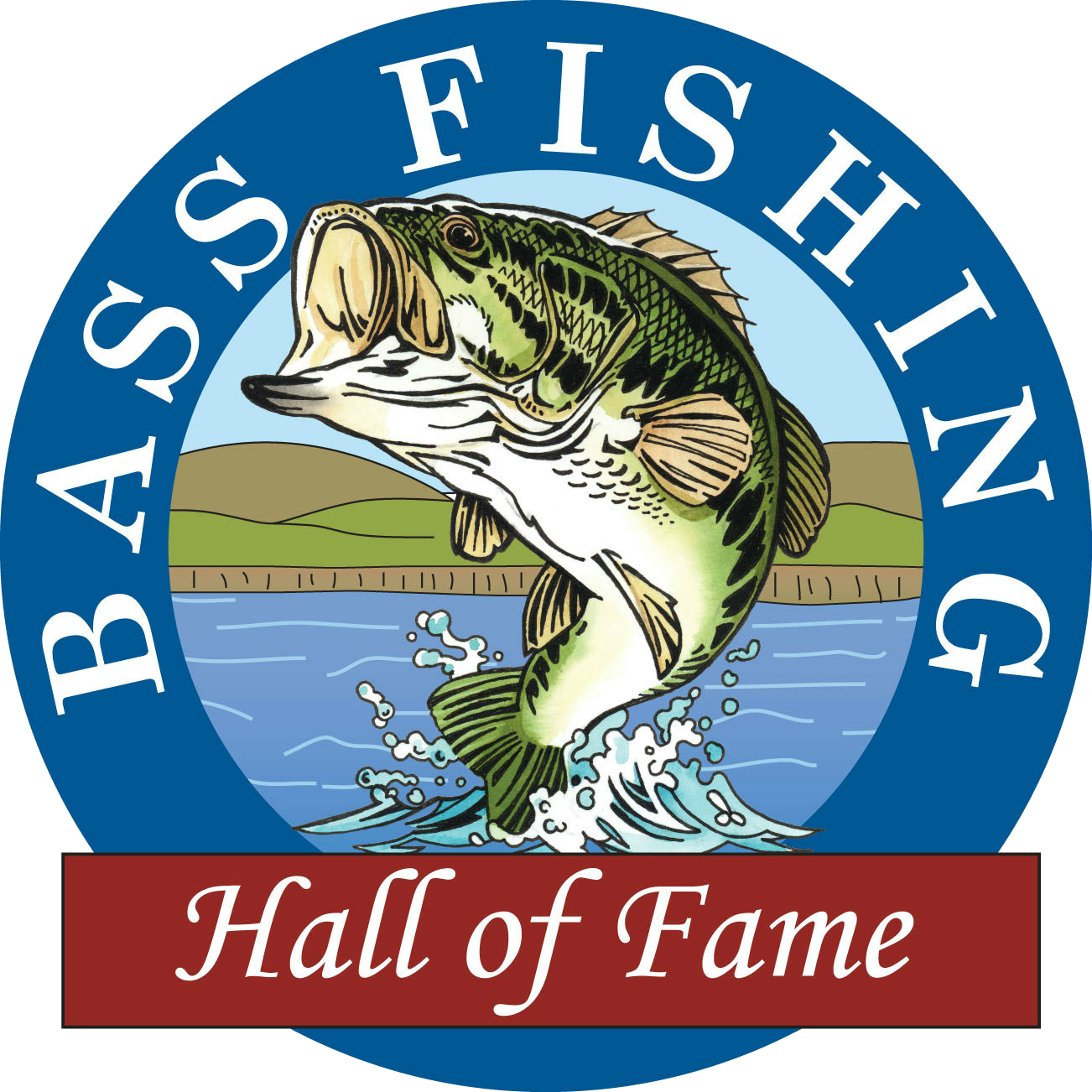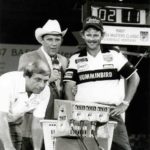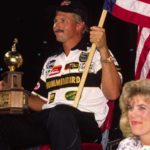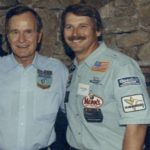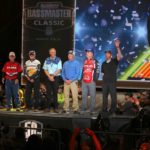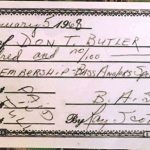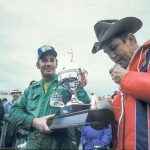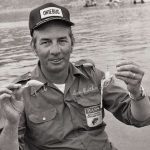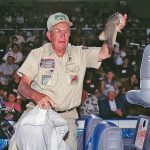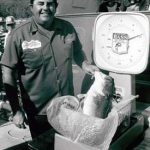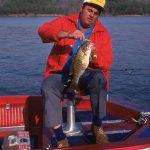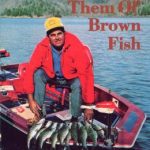Hank Parker
Hank Parker — After many successful years guiding and fishing tournaments around the Carolinas, Hank Parker launched his professional tournament fishing career in 1976, when he began fishing the National Bass Association Tournament Circuit, winning that tour’s national championship in his first season. After competing on the NBA and American Bass Association tours in 1977, he parlayed his growing notoriety into sponsorships that enabled him to join the Bass Anglers Sportsman Society circuit in 1978.
During the course of the next 13 years, he competed in over 100 B.A.S.S. tournaments and finished in the money an astonishing 77 percent of the time.
A force in bass fishing from the beginning, he achieved stardom by winning the 1979 Bassmaster Classic at Lake Texoma, Texas, in only his second year on the tour. He qualified for the prestigious world championship every season he competed, from 1978 through 1990 — an amazing 13 in a row. He became one of the very few individuals to earn more than one Classic title when he won in 1989 on the James River out of Richmond, Virginia, claiming the crown by a 2-ounce margin over Jim Bitter of Florida. It was one of the narrowest winning margins ever.
He finished in the Top 10 in six Classics, never ending up lower than 19th. He won a total of five B.A.S.S. events in those years, including the 1983 Virginia Invitational on the James River, the 1985 Super B.A.S.S. tournament on the St. Johns River, Florida, and the 1988 Missouri Invitational on Truman Reservoir. He also had 32 Top 10s in his career.
Parker was the first angler to win the “Grand Slam” of competitive bass fishing titles, including the Classic, Super B.A.S.S., a regular season tournament, and the Bassmaster Angler of the Year title in 1983.
Bryant Gumbel, when he was host of the CBS Morning Show, described Parker as “the rod-and-reel answer to Michael Jordan, in popularity and talent.”
Despite all those achievements in competitive fishing, Parker is perhaps better known for the career he built as a TV fishing show host after leaving the B.A.S.S. Tour. His long-running “Hank Parker’s Outdoor Magazine” show, which aired on The Nashville Network, ESPN and other networks over the following decades. He lent his name and likeness to a fishing video game on the Super NES platform, “Black Bass with Hank Parker,” released in 1984.
Known for his integrity and loyalty, he continued through decades of competitive fishing and television programming with most of the same sponsors, including Ranger Boats and Mercury Marine.
In addition to his tournament titles, Parker has been inducted into the Bass Fishing Hall of Fame (in 2003), the International Game Fish Association Hall of Fame and the Legends of the Outdoors Hall of Fame.
Even though he fished his first regional bass tournament more than 50 years ago, at only 16 years of age, Parker — like most hall of famers — has never grown weary of fishing. “Whether it’s largemouth, smallmouth, muskie, redfish, any fish . . . I never get tired of fishing,” he said.
Hank Parker
When Tommy Martin first began tournament fishing in 1968, little could he have known that it would lead him into a thirty-five year career. A career that has seen him go from guiding on Lake Sam Rayburn, Texas, in the late 60’s, to guiding on Lake Livingston, Texas, in 1969. From there, he moved on to fishing the Bass Anglers Sportsman Society’s tournament trail in 1972. Since then, he has won 19 national tournament titles, with over one million dollars in prize money. He has qualified for the prestigious BassMasters Classic 19-times and captured five different B.A.S.S. tournament championships: the ’74 Classic; the 1974 Arkansas Invitational; the 1981 Texas invitational; the 1983 Texas Invitational and the 1995 Oklahoma Invitational.
Along with winning the 1974 BassMasters Classic, he became the first professional angler, in B.A.S.S. tournament history, to win both a B.A.S.S. Classic and a regular season tournament, during the same season, when he captured the Arkansas Invitational on Beaver Lake. A feat that has rarely been accomplished since.
He has won tournaments in three different decades. Something that only a couple of other anglers in professional bass fishing have ever accomplished. Today, even though he is in his early sixties, he continues competing successfully along the Citgo BassMaster tour. Tommy Martin has competed in over 280 B.A.S.S. tournaments since he first started fishing them and has taken home a check in more than half of these events.
Tommy Martin
It’s one thing to win bass tournaments, which Tom Mannhas done, but it’s an entirely different matter to design, produce and manufacture fishing lures for the professionals and weekend anglers to use. When he began his lure manufacturing business, in 1958 with $5.00, on his kitchen table, I doubt that anyone, especially himself, thought that it would one day grow into one of the most widely recognized lure companies in the world. While he held down a full-time job, as an Alabama Game warden, his love of catching fish, designing lures and, with the help of a supportive wife, proved to be a winning combination. It didn’t hurt that he moved his business to the tiny town of Eufaula, Alabama, and located his manufacturing plant on the shores of one of the best big bass lakes in the country.
When Lake Eufaula came to the nation’s attention, in the late 60’s and early 70’s, Tom Mann was ready to supply them with the needed lures to land one of those “Alabama lunkers”. His famous “Little George” tail spinner, “Deep Pig” crankbait, “Wooly Bully” spinnerbaits and scented “Jelly Worms” became mainstays in every angler’s tackle box, from California to Connecticut. His world famous “Jelly Worms” were distinguished by being named after different fruits. Who, in the 60’s, 70’s and 80’s didn’t get a funny look from their wife when they told them that they were going fishing with blueberry or watermelon or strawberry worms? Each color in the Mann’s “Jelly Worm” collection was named after a different fruit and had a scent that smelled like that fruit. It wasn’t Tom who named the flavors of the “Jelly Worm” collection, it was his wife, Ann. A supporter for more than fifty years!
Not content with just manufacturing fishing lures, while the owner of Mann’s Bait Company, he also founded and was the C.E.O. of Allied Sports Company, from 1969-1983. As the manufacturer of the “Humminbird Depth Sounder”, Allied Sports eventually became a stock company and was renamed Techsonic Industries: one of the largest selling depth sounder companies in the world. He also founded Southern Plastics, in 1977, a company that today is the world’s largest private brand supplier of soft plastic lures.
Designing and building baits to catch fish, and creating companies that would help every angler on the water, were just a part of his repertoire. He knew how to catch ’em as well, as his success along the Bass Anglers Sportsmans Society tournament trail quickly proved. He began his professional tournament career along the B.A.S.S. tournament trail in 1967 by competing in the Dixie Invitational. In 1971 he captured his first national title by winning the B.A.S.S. Georgia Invitational on Lake Seminole, Georgia. He then followed that impressive victory with another championship performance by winning the 1972 B.A.S.S. Florida National, on Lake Kissimmee, Florida. In all, Tom Mann fished in 104 Bass Angler Sportsman Society tournaments, taking home over $36,000.00. When compared to today’s dollars, that would have been in excess of $700,000. He also qualified for 7 BassMasters Classics and has the distinction of finishing in second place in the very first BassMasters Classic, on Lake Mead, Nevada, behind fellow hall of fame member, Bobby Murray.
He has been inducted into the Freshwater Fishing Hall of Fame, and he received the Fishing Hall of Fame’s highest honor, the Dolphin Award. He has been named as one of Alabama’s most unforgettable faces, by the Alabama Bureau of Tourism and Travel and has authored two of the all time best selling books on bass fishing. Tom Mann is still active in designing fishing lures and also co-hosts a nationally syndicated television program called, “Tom and Tina Outdoors” with his co-host, Tina Booker.
Tom Mann
Don Butler (1930 – 2004)— He’s been called Ray Scott’s “guardian angel” and the “patron saint of bass fishing.” While Don Butler might not have agreed with those descriptions, there’s no doubt Butler came to the rescue at several junctures in the birth and growth of Scott’s Bass Anglers Sportsman Society (B.A.S.S.).
When Scott was organizing his first professional bass tournament, the All American at Beaver Lake, Arkansas, in 1967, Butler convinced enough of his fellow Tulsa Bass Club members to put up $100 entry fees and help make the event a success.
In January 1968, as he was forming B.A.S.S., Scott met with the Tulsa Club — one of the first bass fishing clubs in America — to get its support. The meeting was getting unruly as Scott presented his idea to start an organized society for bass fishermen. Some were skeptical of Scott’s ability to make bass fishing a professional sport like golf. Finally, Butler, who helped found the club, stood up and restored order. “Everybody shut up and let this man tell us what he wants to do,” he said.
By the end of the evening, the Tulsa Bass Club bought into that idea. Butler, a lumberyard owner whose store also sold fishing tackle, soon became the first member of B.A.S.S.
“I did it more to encourage him than to have the elite status of being the first to join,” Butler explained later. “I thought that if I could fire Ray up, then it would inspire him to get the idea going. And I wanted to be part of it. I didn’t know where it was going, and neither did Ray, but I believed in him and his idea to bring us all together.”
Months later, Scott was struggling to push B.A.S.S. over the top and send it on its rollercoaster ride to growth and success. The two talked over the phone on a frequent basis, and during one call Scott told Butler about a warranty card list he needed to buy from Abu Garcia for a direct mail campaign. Valued at $10,000, the list was much too pricey at the time for Scott. The next morning, he received an anonymous Western Union Telegram directing him to go to a local bank. There, he was shocked to collect $10,000 from an unknown donor, which later proved to be Butler.
In addition to being a visionary, Butler was a topnotch angler and an entrepreneur. Back when spinnerbaits were just beginning to catch on, Butler designed and introduced the “S.O.B.,” which stood for Small Okiebug Spinnerbait. That bait earned Butler the title of world champion when he won the second Bassmaster Classic, held in 1972 on Percy Priest Reservoir at Nashville, Tennessee.
Butler earned another B.A.S.S. national tournament title, winning the 1973 Arkansas Invitational, on Beaver Lake, with an incredible catch of 56 pounds, 14 ounces. He fished a total of 26 tournaments before health issues forced him to retire. But during his brief career, Butler finished in the Top 10 in half of the events he fished, and he almost always ended in the Top 30.
Recognizing business opportunities in the fishing industry, Butler founded a wholesale tackle business he called Okiebug Distributing Co. One of his early customers was an up-and-coming pro angler on the B.A.S.S. Tournament Trail who was getting into the retail business. The young man, Johnny Morris, would fill up a U-Haul trailer with bass baits and tackle from Butler’s warehouse and haul it back to Springfield, Missouri, to stock his Bass Pro Shops store.
When Scott introduced catch-and-release to bass fishing and mandated that tournament contestants keep their catch alive, it was Butler who designed the first aerated livewell.
A dedicated conservationist, Butler also donated his time and resources to programs designed to introduce youngsters to fishing and other outdoor sports.
Reflecting on his support and encouragement of Ray Scott and his grand scheme of organizing bass anglers, Butler recalled, “It was hard to believe what he said back then. Some people were cynical, and others believed in it like I did. Now, to see it really happen has been a great, fulfilling reward to me.”
Butler died in December 2004 after a long battle with cancer. He was 74 years old.
Don Butler
Jerry McKinnis (1937 – 2019) Jerry McKinnis comes to us as one of the elite few who will ever be inducted into the Hall of Fame, who did not make his living as a full-time tournament fisherman. Instead, he made it through almost forty years of providing outstanding television programming to millions of viewers around the world. Born in St. Louis, Missouri, and still a fan of the St. Louis Cardinals, he came into fishing rather naturally when he moved to the state of Arkansas at an early age.
He began his fishing and business career on the famous White River where he was one of the more popular fishing guides to be found. As his business knowledge moved forward, so did he. After moving to Little Rock, Jerry found that his fishing prowess provided him ample opportunities to “get in front of the camera” when he started giving fishing reports from area lakes. Wanting to provide as much coverage to fishing as possible, he purchased a film camera so that he could show his audience his weekly catches. From the mid 60’s until 1979, his man’s weekly fishing program, “The Fishin’ Hole” was seen around America, in spot markets. In 1979 he and his business partner Jim Manion took “The Fishin’ Hole” to a national audience, when they signed on with a relatively new sports broadcasting network called, “ESPN”. In march 2000, “The Fishin’ Hole” celebrated it’s 36th season on the air and its 20th year as being the anchor of ESPN’s outdoors block. “The Fishin’ Hole” is the second longest running program on ESPN, behind the wildly popular “Sport Center”.
ESPN’s programming director, Gary Morgenstern, has even said that this man’s production company, JM Associates, “is this network’s best friend.” In addition, JM Associates produces a number of different fishing and outdoor programs for ESPN, inc;uding: “The Spanish Fly”; “The Guides” with Bobby and Billy Murray; “The Bass Class” with Denny Brauer; the Citgo BassMaster Tournament Trail and Rick Ruoff’s “Orvis Sporting Life”. JM Associates also produced the Iditarod sled dog race; the Wal*Mart FLW Tour; ESPN’s Stihl Timbersports series; the U.S. Open Racquetball Championship; Great American Events; and countless other specials. In the late 60’s, when fellow Hall of Fame member Ray Scott was getting his Bass Anglers Sportsman Society off the ground, Jerry found time to compete, and succeed, with the early day heroes of bass fishing. While the prize money wasn’t what it is today, our inductee did take home checks in two/thirds of the tournaments he competed in.
Jerry McKinnis
Billy Westmorland (1937 – 2002) — No angler is more synonymous with smallmouth bass fishing than Billy Westmorland. Born in Clay County, Tennessee, in 1937, Westmorland grew up a short cast from Dale Hollow Reservoir, a deep, clear TVA impoundment straddling the Tennessee and Kentucky borders that held giant smallmouth.
While a schoolboy, he would hang around docks on the lake chatting with the local guides and picking their brains about smallmouth fishing. Many of these old timers had hunted rabbit and quail in the hills and “hollers” that were flooded following the dam’s construction; they knew every inch of what lay beneath the lake’s surface and often shared their knowledge with the eager youngster. Westmorland occasionally skipped school to go fishing, and he became obsessed with catching smallmouth as big as the ones the guides would bring back to the docks. By the time he was 13 years old, Westmorland knew the 27,700-acre reservoir well enough to start guiding from a rental rowboat. At first he’d have to wait around the dock until all the other guides had been booked before getting a client, but word eventually spread throughout the lake that “the kid” knew what he was doing and Westmorland began getting regular bookings, often from repeat customers.
While most of Dale Hollow’s veteran guides trolled big diving plugs or fished live bait on heavy tackle for smallmouth, Westmorland gained a reputation for catching giant bronzebacks on light spinning tackle, routinely using 4- and 6-pound line and small lures like the “fly and rind” (a tiny hair jig with a pork rind trailer); this was before the term “finesse fishing” had even been coined. Through his insatiable curiosity about smallmouth, Westmorland learned the depth ranges, bottom compositions and types of structure most likely to hold the biggest fish. He also discovered that trophy-class smallmouth often become most aggressive on the roughest, nastiest winter days.
Westmorland may be the only bass angler to have ever caught both a 10-pound largemouth and a 10-pound smallmouth (his biggest bronzeback weighed 10 pounds, 1 ounce on certified scales). In his classic memoir on smallmouth fishing, “Them Ol’ Brown Fish,” Westmorland told of hooking and losing a behemoth smallmouth one blustery Christmas day on Dale Hollow that he felt sure would have beaten the world record (11 pounds, 15 ounces – also from Dale Hollow). Outdoor writers spread the word about Westmorland’s smallmouth-catching prowess through newspaper and magazine articles. As his reputation grew, he began designing and endorsing lures and tackle geared specifically to smallmouth, a segment of the bass fishing market that had previously been virtually ignored.
In the early 1970s, Westmorland joined Ray Scott’s fledgling B.A.S.S. Tournament Trail and proved to be expert at catching big largemouth as well as big smallmouth. He competed in B.A.S.S. tournaments for seven years, qualifying for the Bassmaster Classic six times and winning three Tournament Trail events.
In the 1980s he became one of the first professional anglers with his own television show, “Billy Westmorland’s Fishing Diary.” Long before the advent of email, Westmorland would spend hours personally responding to fishing fans across North America who wrote him asking for his smallmouth fishing insights. Although his birth name was spelled “Westmoreland,” he claimed to have dropped the second “e” because it allowed him to sign autographs more quickly.
Westmorland died in 2002 at age 65 and is the first angler to be inducted into the Bass Fishing Hall of Fame posthumously. The stretch of highway between Celina, Tennessee, and Horse Creek Resort (the Dale Hollow dock that Westmorland frequented) has been officially designated as the Billy Westmorland Memorial Highway by the State of Tennessee.
